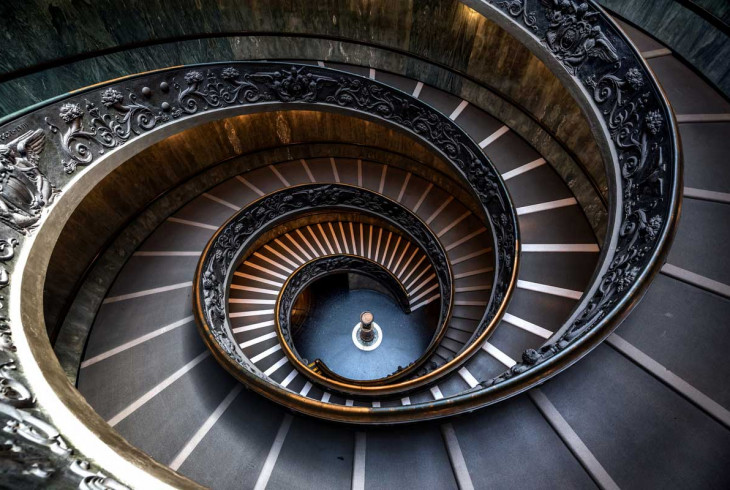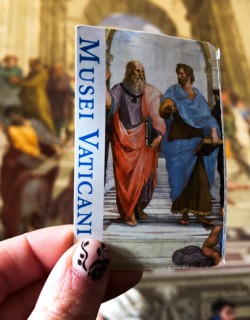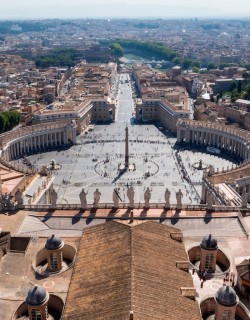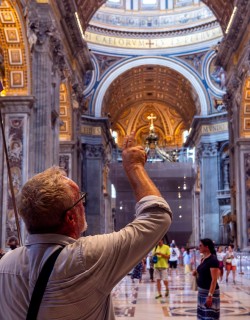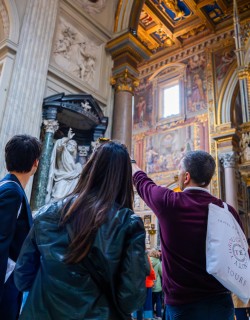So you’re planning your second trip to Rome. Convinced that you only barely scratched the surface the first time around, you fancy another jaunt to the Vatican Museums but want to spend less time surrounded by huge crowds. I have been leading tours of the Vatican Museums for over two decades, so let me guide you through the quieter rooms of the collection with my guide to the top hidden masterpieces of the Vatican. don't forget that Through Eternity offers award-winning tours of the Vatican on a daily basis.
Table of Contents
- 1.Caravaggio’s Entombment of Christ
- 2.The Porphyry Basin in the Round Hall (Sala Rotonda)
- 3.The Bronze Pinecone
- 4.The Mars of Todi
- 5.The Augustus of Prima Porta
- 6.Chryselephantine Statue of Athena
- 7.The Mosaic of the Un-Swept Floor (Asàrotos òikos)
- 8.Aldobrandini Wedding Fresco
- 9.Giovanni Antonio Vanosino’s Celestial Globe
- 10.Giuseppe Momo’s Spiral Staircase
1.Caravaggio’s Entombment of Christ

Where: The Pinacoteca Vaticana (Picture Gallery)
Hidden away in a quiet corner of the Museums, the Vatican contains one of the world’s finest art-galleries – but most visitors don’t even step inside, which is a real shame. One of the most captivating images here, and one that absolutely commands your attention, is Caravaggio’s Entombment of Christ, a startling statement of the artist’s revolutionary style that marked a seismic break with the ideals of the Renaissance.
Instead of the heroic Christ that artists of an earlier age were so fond of, Caravaggio confronts us with a heavy corpse. The elderly Nicodemus struggles mightily to support his dead weight, hunched-back doubled over in exertion. His dirty bare feet and age-lined face represent Caravaggio’s commitment to realism. For contemporaries used to the idealised images that flowed from the brushes of artists such as Raphael, the fact that this holy figure looked just like any impoverished old man you might see shuffling along the Roman streets was a shocking provocation. Behind him, three women express different kinds of mourning: one raises her hands to the sky in grief, another tenderly dries tearful eyes, whilst the Virgin Mary simply stares with burning intensity at her son’s lifeless body. Caravaggio’s vision reflected a new kind of popular spirituality that sought to bring the world of God into direct contact with the everyday, and was wildly popular despite the controversy he courted. The spot-lit figures loom dramatically out of the inky-black space of the tomb, an incredible example of the extreme chiaroscuro that made Caravaggio’s work so spectacular and that would come to define the age of the Baroque.
Don’t Miss: As you make your way through the Pinacoteca, look out too for highlights such as the pioneering work of Giotto that helped usher in the Italian Renaissance, Raphael’s magnificent Transfiguration – his final painting - and Leonardo’s trailblazing depiction of Saint Jerome in the Wilderness.
2. The Porphyry Basin in the Round Hall (Sala Rotonda)
Where: The Pio-Clementino Museum
The Round Hall forms part of the Pio-Clementino museum of ancient sculpture, not far from the Octagonal Courtyard (home of the iconic Laocoon and Apollo Belvedere). It was constructed in the 18th-century by Michelangelo Simonetti with a hemispherical vault imitating the ceiling of the Pantheon in spectacular miniature. Dominating the hall is a massive Roman basin of precious red porphyry that probably originally came from an ancient bath (perhaps even Nero’s Golden House), and a giant bronze statue of a young Hercules draped in a lion’s skin, leaning on a club. The sculpture had been struck by lightning and ritually buried following Roman custom, and was only rediscovered in 1864.
Don’t Miss: Make sure to cast a glance downwards too – the floor is an incredible series of ancient mosaics from an Umbrian bath representing sea gods and battles, assembled together in an intricate pattern in the 18th century.
3.The Bronze Pinecone
Where: The Pinecone Courtyard
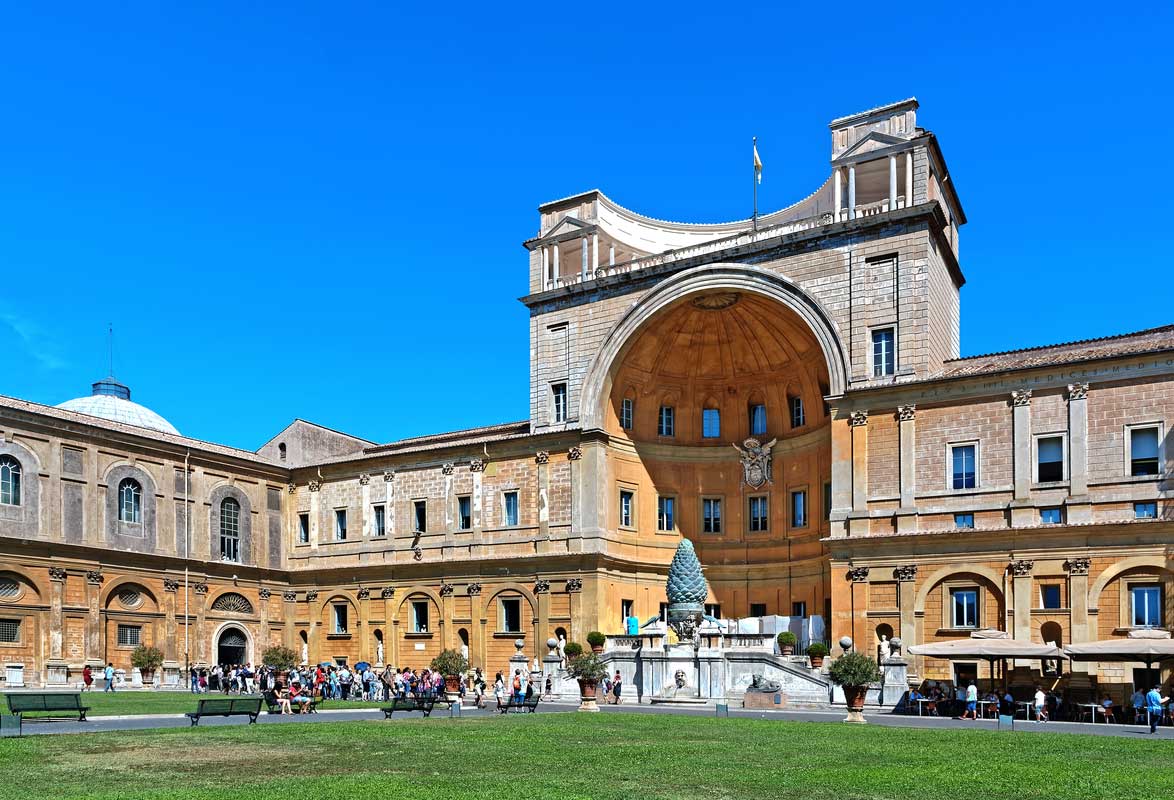 The enormous bronze pinecone that gives its name to the Pinecone Courtyard was probably originally cast as the centrepiece of a fountain in the centre of the ancient city, possibly part of a temple to the Egyptian god Isis, and dates from the second century AD. It was found in the Campo Marzio in the Middle Ages and for centuries was positioned in the atrium of Old St. Peter’s basilica. It was moved to the Vatican in 1608, where it adorned Donato Bramante’s famous Belvedere Courtyard (the current Pinecone courtyard is only about half of Bramante’s original design). The beautiful bronze peacocks that accompany the Pinecone are now reproductions, but you can still see the originals in the Braccio Nuovo wing of the Museums nearby. For the ancient Romans peacocks were a symbol of immortality, and these bronze birds were originally cast for the tomb of the emperor Hadrian (today Castel Sant’Angelo), before being moved to old St. Peter’s to keep the Pinecone company.
The enormous bronze pinecone that gives its name to the Pinecone Courtyard was probably originally cast as the centrepiece of a fountain in the centre of the ancient city, possibly part of a temple to the Egyptian god Isis, and dates from the second century AD. It was found in the Campo Marzio in the Middle Ages and for centuries was positioned in the atrium of Old St. Peter’s basilica. It was moved to the Vatican in 1608, where it adorned Donato Bramante’s famous Belvedere Courtyard (the current Pinecone courtyard is only about half of Bramante’s original design). The beautiful bronze peacocks that accompany the Pinecone are now reproductions, but you can still see the originals in the Braccio Nuovo wing of the Museums nearby. For the ancient Romans peacocks were a symbol of immortality, and these bronze birds were originally cast for the tomb of the emperor Hadrian (today Castel Sant’Angelo), before being moved to old St. Peter’s to keep the Pinecone company.
Don’t Miss: Check out the modernist masterpiece by the hand of Italian sculptor Arnaldo Pomodoro that faces the ancient pinecone from the centre of the courtyard. A rotating bronze globe, the iconic work is understatedly entitled Sphere Within Sphere and has sister works across the globe – from United Nations headquarters in New York to Trinity College, Dublin.
4. The Mars of Todi
Where: The Gregorian Etruscan Museum
Pope Gregory XVI founded this part of the museums in 1837 to house the vast number of Etruscan artefacts that successive popes had unearthed in Southern Etruria, one of the key parts of the Papal States. Providing a fascinating insight into the daily life, art and culture of the ancient Etruscan people, more venerable even than the Romans themselves, they are too good to miss. The Etruscan museum is always quiet, so popping in here is also a welcome respite from the crowds. Amongst the many beautiful statues in the collection, best of all is the exceptional Mars of Todi - a life-size bronze sculpture of a warrior with a distinctive Etruscan face in military fatigues and detailed armour. Statues like this were left at religious shrines as votive offerings. His solid, no-nonsense expression and squat features are far from ideals of Greco-Roman athleticism and intellectualism.
Don’t Miss: Other highlights of the collection include haunting clay statues of mourners that surrounded the precious funerary bed of the Regolini-Galassi tomb, a 7th-century BC sepulchre from Cerveteri to the north of Rome, a stunning bronze mirror carved with an Etruscan soothsayer reading the future in an animal’s liver and an ancient child’s doll with moveable limbs.
5. The Augustus of Prima Porta
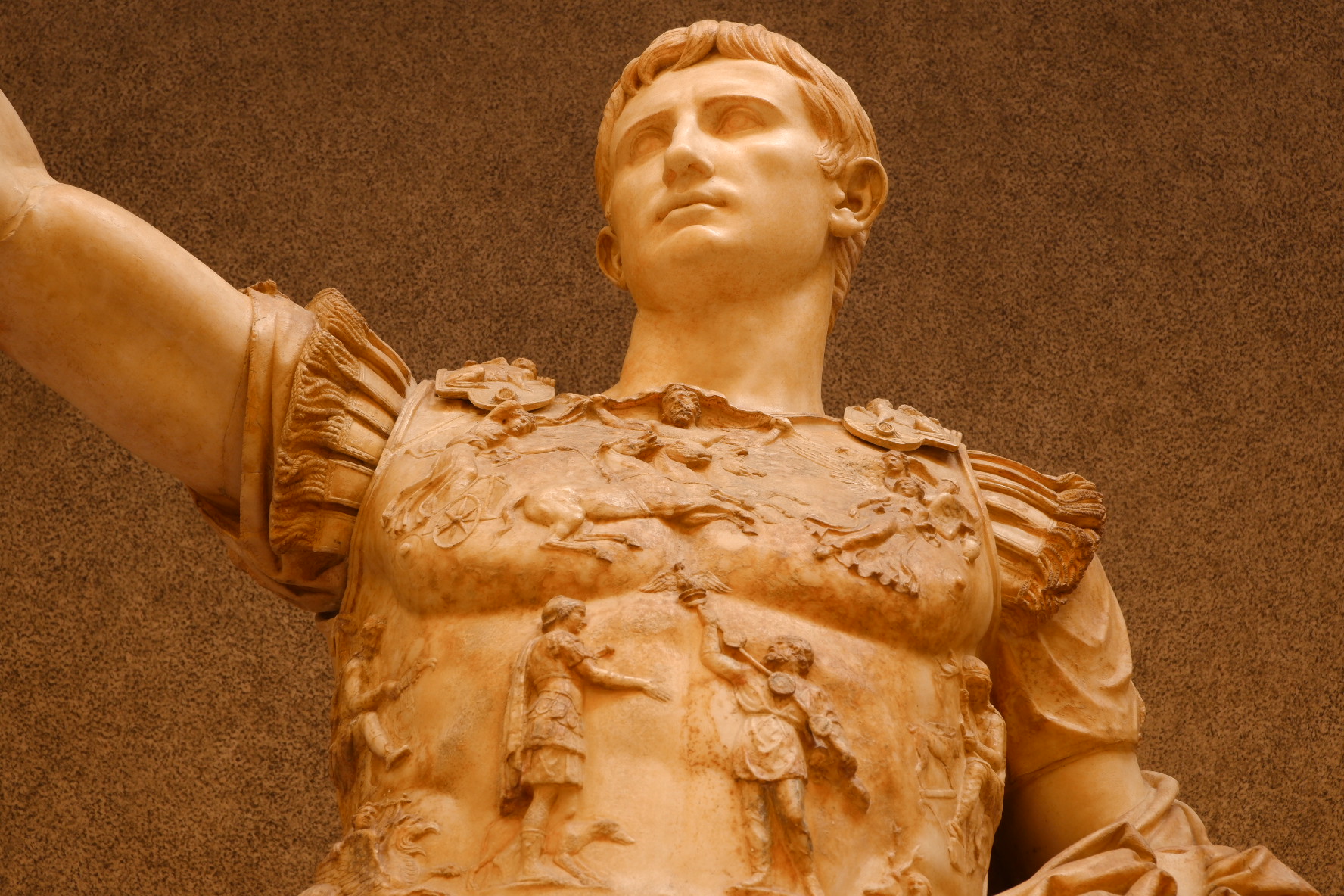
Where: The Braccio Nuovo (New Wing)
Recently reopened to the public after a long restoration, the magnificent Neo-Classical gallery known as the Braccio Nuovo, or New Wing, is one of the best-kept secrets of the Vatican Museums. Find it at the very end of the Chiaramonti gallery, branching off to the right-hand side and leading towards the Vatican Library and Pinecone Courtyard. This beautiful cul-de-sac was built under Pius VII in the 1820s to house works returning to Rome that Napoleon had plundered a decade before, and contains some of the absolute masterpieces of the Vatican’s collection of classical art, laid out by the renowned neo-classical sculptor Antonio Canova. First-amongst-equals is perhaps the Augustus from Prima Porta, an imposing sculpture depicting Rome’s first emperor as a triumphant army commander. The statue was commissioned to celebrate the emperor’s victory over the Parthian people in 20 B.C., and features a youthfully energetic Augustus right at the top of his game. As if to underline his success, the imperious emperor wears a distinctive military cuirass decorated with a scene depicting the recovery of a military standard lost by the Roman legions 70 years earlier. In 2004, a reconstruction of the statue’s originally polychromatic appearance by the Vatican’s conservators caused a massive stir, and the debate as to what extent the sculpture was painted still rages.
Don’t miss: Look out for the original peacocks that once flanked the bronze Pinecone in the same gallery, where they now frame a marble bust of Pius VII. Keep an eye out too for Silenus Cradling the Infant Bacchus, a Roman copy of a Greek masterpiece by Praxiteles, and one of the tenderest expressions of a relationship between a father and child ever depicted (Silenus was technically Bacchus’ mentor, but basically also his foster-father). The profoundness of Silenus’ gaze is incredibly moving.
6.Chryselephantine Statue of Athena
Where: Clementine Gallery II, Profane Museum
Not too many visitors stop on their way through the Profane museum, but it’s absolutely worth pausing at this haunting fragmentary sculpture of the goddess Athena - an incredibly rare example of an ancient sculptural technique known as chryselephantine. The term derives from the Greek words for the priceless materials used in the method, chrysòs and elephàntinos - gold and ivory. Chryselephantine statues were constructed around sturdy wooden frames, upon which extremely thin slabs of carved ivory would be attached to portray flesh. Sheets of gold leaf (now lost from the Vatican sculpture) completed the ensembles, used for details like garments and hair. The intricate technique was not a common one, and was typically only deployed for religious and cult objects of the highest importance. White represented the purity of light itself in antiquity, rendering ivory the ideal material manifestation of divinity – perfect for depicting for gods and emperors. Given the high value and the inherent fragility of these works, very few have survived intact from antiquity. Athena’s beautiful face, staring imperiously down at viewers from her perch in the Vatican gallery, dates from the period of the emperor Hadrian and was unearthed in a Roman villa in 1824. It is without doubt one of the finest examples of chryselephantine sculpture in the world.
Don’t Miss: In the nearby Hall of the Profane Museum, look out for a fascinating ancient jointed doll fashioned from precious ivory. The beautiful object is a great example of the fashion for children’s dolls made from ivory or bone in Imperial Rome, and features anatomically accurate physiognomy as well as a natty hairdo.
7.The Mosaic of the Un-Swept Floor (Asàrotos òikos)
Where: The Gregorio Profano Museum
The Gregorio Profano museum is the Vatican’s newest wing, a light-filled modernist gallery built in 1970 to showcase ancient works that had been consigned to dusty storage for decades due to a shortage of space. There are some really interesting mosaics in here, and its definitely worth a stop as you make your way out of the Museums - you have to pass them by on your way from the Sistine Chapel to the exit in any case, and like many of the other places featured on this list, you may find it practically deserted.
Our favourite item on display here is the incredible Asàrotos òikos (Un-swept Floor) mosaic that once adorned the dining-room floor of an ancient 1st-century-AD villa on the Aventine Hill. The mosaic represents the illusionistic detritus of the aftermath of a wild banquet – chicken bones and lobster claws, grapes and cherries, shellfish, snails, fish-heads, oyster shells and more. The mosaic provides a fascinating insight into the culinary habits of the ancient Roman aristocracy, and must have been a luxurious status symbol through which the owner wowed his dining companions. Some scholars theorise that the mosaic had a funerary function too, as during Roman banquets honouring the dead guests would offer food to the spirit of the deceased by throwing it to the floor. The quality of the mosaic work, signed by the Greek artist Heraklitos, is extremely high, as evidenced by the miniscule size of the tesserae (tiles). In an incredible feat of illusionism, each item casts its own tiny mosaic shadow. The mosaic is full of humorous visual jokes as well: keep your eye out for an opportunistic little mouse nibbling on a walnut as the pie-eyed revellers are presumably sleeping off their excesses off-camera.
Don’t miss: Whilst you’re here, take a look at the exquisite 4th-century mosaics that once adorned the floor of a library in the Baths of Caracalla. Here muscular ancient athletes and gladiators stand proudly nude, arms protected by strapped leather cesti, hair tied up in the distinctive man-bun of the athlete classes known as a cirrus, and torsos rippling in perfection - it’s not difficult to appreciate why they were the pin-ups of the ancient world.
8.Aldobrandini Wedding Fresco
Where: Sala delle Nozze aldobrandine, Musei della Biblioteca Apostolica Vaticana
This ancient fresco in the Room of the Aldobrandini Wedding comes from the age of Augustus and offers an insight into ancient wedding rites. At the centre the bride, whose head is veiled, is looking seriously nervous at the prospect of her wedding night as she sits on her luxurious bed, and is being counselled and comforted by a goddess - probably Aphrodite, goddess of love. Other goddesses perform sacrifices and other rituals around them. On the threshold of the bridal chamber, a swarthy man identified as the groom or the god Hymen is waiting to enter.
Don’t Miss: The first-century BC fresco cycle depicting the adventures of ancient literary hero Ulysses from Homer’s Odyssey. Found in 1848 during excavations of an ancient house on present day Via Cavour, the lively painting features dramatic events such as Ulysses’ fleet being decimated by the Laestrygonians and Ulysses descending into the underworld to encounter the shades of the dead.
9.Giovanni Antonio Vanosino’s Celestial Globe
Where: Gallery of Urban VIII, Musei della Biblioteca Apostolica Vaticana
As you pass through the Christian Museum on your way to the Museum exit, don’t miss this lavishly painted 16th-century wooden globe. The hollow wooden sphere represents an idealised but cosmologically accurate map of the Ptolemaic constellations in the night sky as seen from the northern hemisphere, surrounded by cavorting angels and mounted on a spectacular golden stand. Long attributed to Raphael’s greatest student Giulio Romano, the globe is now considered to be the work of Giovanni Antonio Vanosino, a virtuoso Ptolemaic scholar whose cartographic skills were instrumental in the decorations of the jaw-dropping Palazzo Farnese in Caprarola, as well as the Vatican’s own Hall of Maps. The globe was made for the Austrian born noble Markus Sitticus Altemps (whose Roman palace is now a museum in the heart of the city), and provides a stunning example of the 16th century’s burgeoning interest in the scientific study of the cosmos. The entire gallery housing Vanosino’s globe is worth checking out for its collection of early-modern cartographic, astrological and scientific instruments and artworks.
Don’t Miss: The magnificent Mannerist frescoes that decorate the walls of this suite of rooms, which began life as part of the Vatican’s extensive library in the 16th century. The frescoes depict the various achievements of Pope Sixtus V, from re-erecting fallen ancient obelisks to transforming Rome’s urban landscape.
10.Giuseppe Momo’s Spiral Staircase
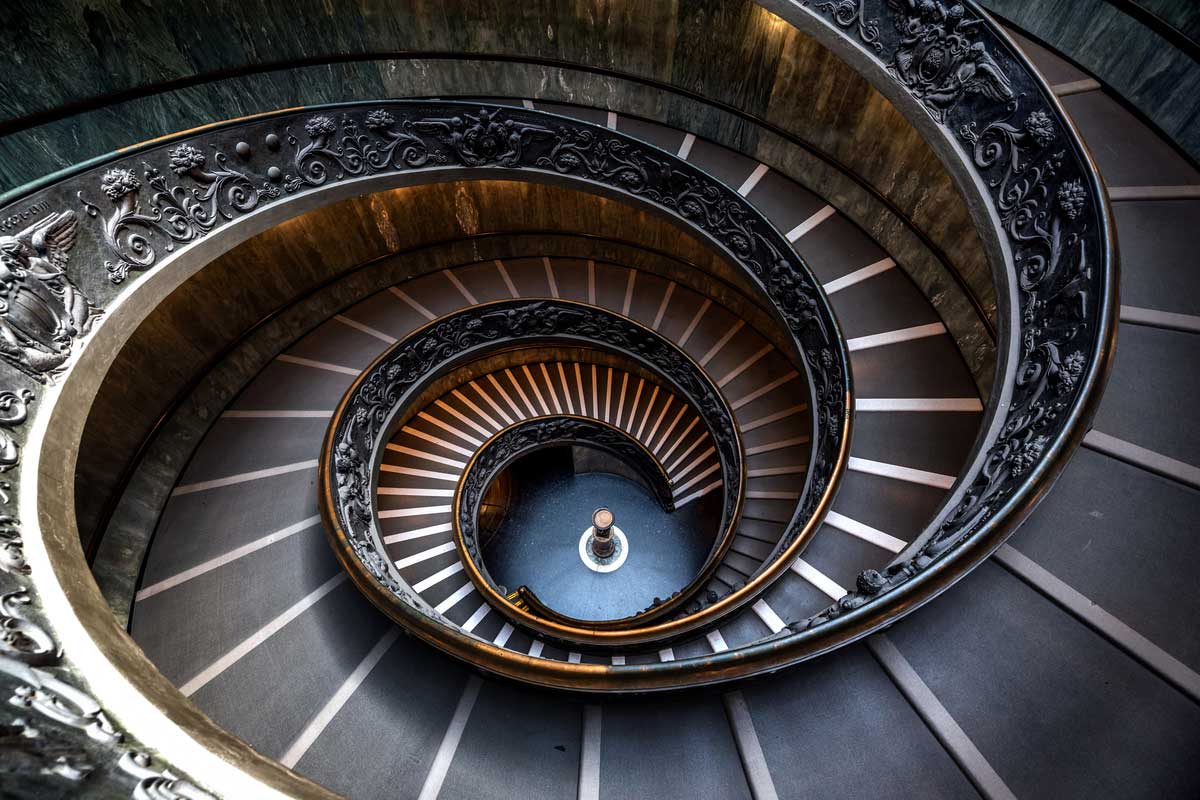
Where: Linking the Gift Shop to the Museum Exit
If anything sums up the special nature of the Vatican Museums, it’s the fact that even the exit ramp is a spectacular work of art in its own right. The magnificent spiral staircase was designed by Giuseppe Momo in 1932, inspired by a famous staircase built by Donato Bramante in 1505 linking the Belvedere Palace to the outside world (unfortunately the Bramante staircase is not usually open to the public). The modern staircase is in the shape of a double helix, like human DNA, and enables people to ascend and descend simultaneously without ever crossing paths. Its beautiful spiral shape and fabulous art-deco metalwork details makes it the last must-see highlight in the museums.
✅ We hope you enjoyed our personal guide to some of the Vatican’s overlooked treasures. If you’d like to see some of these off-the-beaten pack masterpieces in the company of an expert guide, then check out our in-depth VATICAN TOURS, where take you beyond the highlights to explore some of the Vatican’s most fascinating corners.
Read More Great Content From Our Blog
- How to visit the Colosseum in 2024: Tickets, Hours, and More
- 7 Things you Need to Know About the Trevi Fountain
- Visiting the Vatican Museums and St. Peter's Basilica: The Complete Guide
- 9 Things You Need to Know About the Pantheon in Rome
- 5 Reasons to Explore Italy with Through Eternity
- The Best Catacombs to Visit in Rome
- A tribute to the art of sculpture: the treasures of the Octagonal Courtyard at the Vatican Museums
- The Devil is in the Details: Hidden Secrets of the Vatican Museums
- Laocoon sculpture in the Vatican Museums
- The Resurrection of Christ in Vatican Museum's Tapestry Gallery
